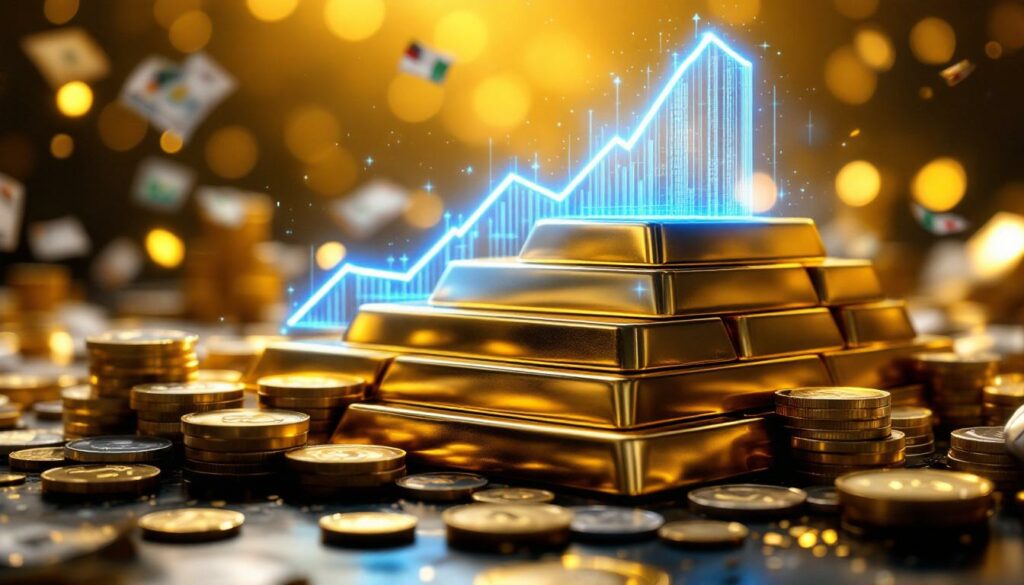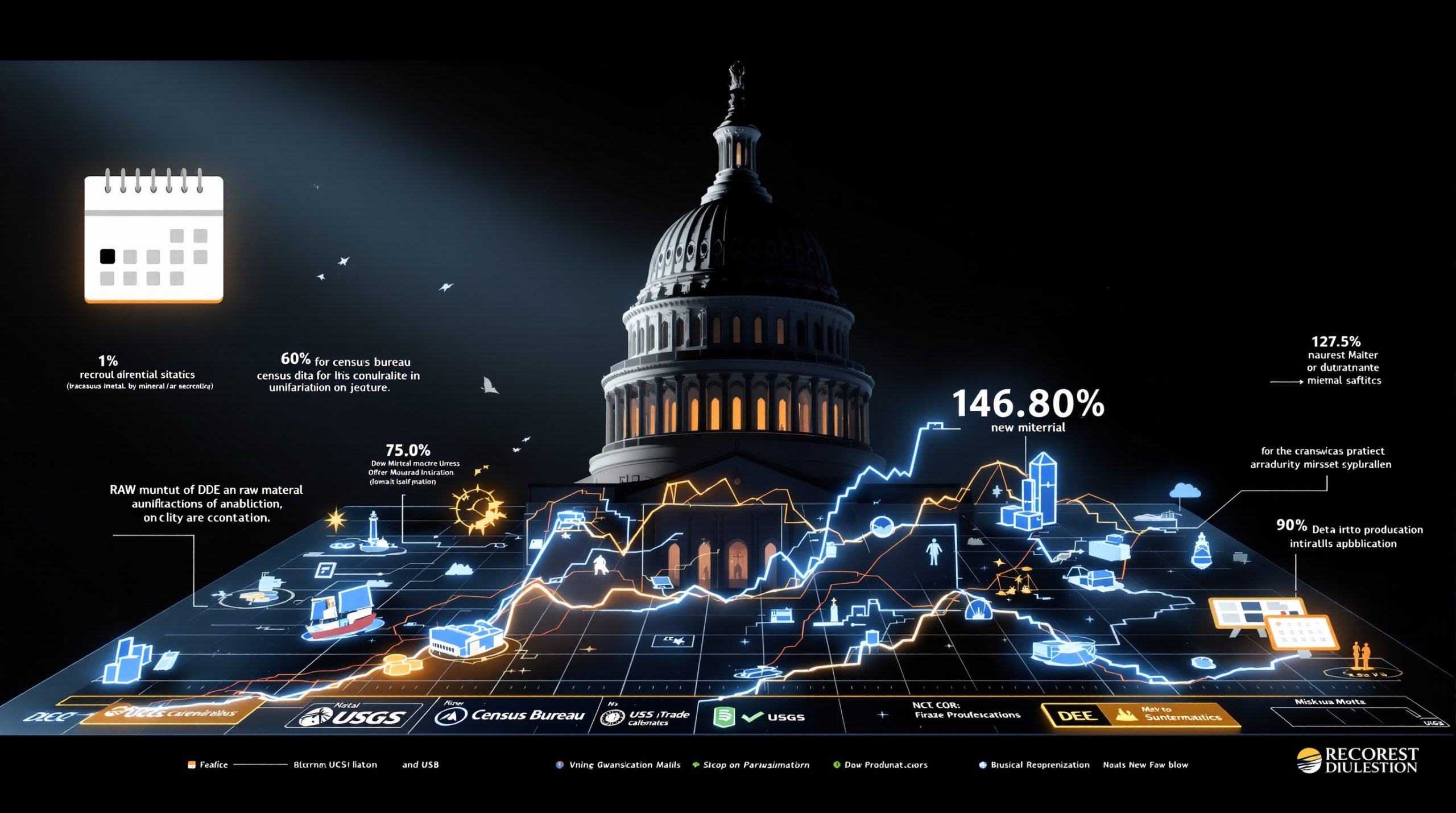What Is the Gold Standard and Why Is It Being Reconsidered?
The gold standard represents a monetary system where a country's currency is directly linked to gold, with the government guaranteeing the ability to exchange currency for a specified amount of gold. This system provided stability and prevented excessive money printing by governments, as each unit of currency was backed by physical gold reserves.
Today's fiat currency system faces significant challenges including inflation, currency devaluation, and financial instability. According to recent World Bank data, OECD nations have experienced average inflation rates of 6.1%, reigniting interest in alternative monetary frameworks. The ongoing devaluation of purchasing power has many economists questioning the sustainability of unbacked currencies, especially considering current inflation and debt factors.
Gold's intrinsic characteristics—durability, scarcity, divisibility, and universal recognition—make it an ideal monetary anchor. Unlike fiat currencies that can be created without limit, gold's physical constraints provide natural boundaries to monetary expansion, potentially limiting inflationary pressures and currency manipulation.
The Historical Foundation of the Gold Standard
The classical gold standard era (1873-1914) represented a period of remarkable monetary stability and international trade growth. During this time, major economies maintained fixed exchange rates by backing their currencies with gold at predetermined rates, creating a system of automatic adjustments that prevented sustained trade imbalances.
The Bretton Woods system (1944-1971) represented the last formal international gold standard, where the U.S. dollar was convertible to gold at $35 per ounce, with other currencies pegged to the dollar. This system collapsed when President Nixon suspended gold convertibility, leading to the current era of floating exchange rates and fiat currencies.
Modern Monetary Challenges Driving Reconsideration
The 2008 financial crisis and subsequent quantitative easing programs exposed fundamental weaknesses in the current monetary system. Central banks have increased global money supply at unprecedented rates, with the Federal Reserve's balance sheet expanding from approximately $800 billion in 2008 to over $8 trillion by 2023.
"The destruction our current monetary system creates worldwide is becoming increasingly apparent. A return to sound money principles isn't just theoretical—it's becoming a practical necessity." — Bart Brands, Gold Republic
The erosion of purchasing power has accelerated in recent years, with many currencies losing 30-50% of their value against essential goods and services in just the past decade. This widespread devaluation has sparked renewed interest in monetary alternatives that offer greater stability and resistance to manipulation, leading many investors to consider various gold investment strategies.
The Fundamental Appeal of Gold as a Monetary Anchor
Gold has maintained its monetary role across 5,000 years of human civilization, outlasting every fiat currency experiment. This unparalleled track record of value preservation stands in stark contrast to the average lifespan of unbacked paper currencies, which historically survive only about 50 years before collapse or significant reformation.
The gold standard's key advantage lies in its discipline—governments cannot create gold out of thin air. This natural constraint forces fiscal responsibility and prevents the hidden taxation of inflation that erodes citizens' savings and distorts economic signals.
Why Is the Return to a Gold Standard Considered Inevitable?
The existing monetary framework shows increasing signs of strain, with persistent inflation, growing wealth inequality, and recurring financial crises. These systemic issues suggest fundamental flaws that may ultimately necessitate a return to asset-backed currencies to restore stability and trust.
"I think there is an inevitability when it comes to the reintroduction of a gold standard. When you're seeing the destruction our current monetary system creates worldwide—corruption would die instantly." — Bart Brands, Gold Republic
The current paper-to-physical gold ratio of approximately 100:1 demonstrates the fragility of the existing system, where claims on physical metal vastly exceed available inventory. This leverage creates potential for market disruption should even a small percentage of paper claim holders demand physical delivery.
The Systemic Failures of the Current Monetary System
The cycle of debt expansion and monetary intervention has created unprecedented global debt levels, exceeding 350% of global GDP according to the Institute of International Finance. This debt burden has become increasingly unsustainable, requiring ever-larger monetary interventions to prevent systemic collapse.
Negative real interest rates have become the norm in many developed economies, distorting capital allocation and creating asset bubbles while penalizing savers. This environment undermines fundamental economic principles and encourages speculative rather than productive investment.
The wealth gap has widened dramatically under the current monetary regime, with asset price inflation benefiting primarily those who already own financial assets. This structural inequality threatens social cohesion and economic stability, driving calls for monetary reform.
Growing Global Distrust in Fiat Currencies
Public confidence in government-issued currencies continues to erode as monetary policies lead to currency devaluation and economic uncertainty. This declining trust is evidenced by increasing investment in precious metals and alternative stores of value, indicating a grassroots movement toward more tangible assets.
Gold Republic has observed accelerating growth rates in transaction volumes, with annual increases of 25-40% in precious metals purchases. This trend reflects growing investor concern about monetary stability and inflation risks, driving a shift toward tangible assets including gold as safe haven.
Several nations, including Russia, China, and India, have significantly increased their gold reserves in recent years while reducing U.S. dollar holdings. This strategic reallocation suggests preparation for a potential monetary reset or hedging against dollar devaluation.
Technological Innovations Enabling a Modern Gold Standard
Modern technologies, particularly blockchain and digital verification systems, have created new possibilities for implementing a gold standard that addresses historical limitations. These innovations allow for efficient ownership transfer, transparent auditing, and secure storage verification that weren't possible in previous gold standard eras.
Digital gold currencies utilizing blockchain technology can provide the efficiency of electronic payments while maintaining 100% backing by physical gold. This combines the stability of gold with the convenience of modern payment systems.
Distributed ledger technology enables real-time auditing and verification of gold reserves, addressing one of the historical challenges of the gold standard—ensuring that claimed reserves actually exist and are unencumbered.
How Might a Modern Gold Standard Function?
A contemporary gold standard could combine physical gold ownership with blockchain technology to create a hybrid system. This approach would enable the benefits of gold's stability while allowing for the convenience and efficiency of digital transactions, potentially creating a more robust monetary framework.
Gold Republic's technology already demonstrates how this might work through "daily transfer of legal ownership" of physical metals. This innovation connects the digital and physical worlds through blockchain verification and continuous monitoring systems.
Integration of Physical Gold with Digital Technologies
A modern gold standard would leverage blockchain technology to track ownership claims and transfers while ensuring all digital tokens are backed by allocated physical metal. This transparent chain of custody eliminates counterparty risk and prevents fractional reserve practices.
"Technology allows us to verify 100% allocation through blockchain records, surveillance systems, and digital auditing tools. The gold is there, verified, and legally owned by the customer—not the custodian." — Bart Brands
Smart contracts could automate gold-backed currency issuance and redemption, creating a transparent, rules-based monetary system resistant to political manipulation. This programmable money approach eliminates the need for trusted third parties while maintaining gold's stability benefits.
Multi-signature security protocols would safeguard physical gold reserves while allowing for efficient transfer of ownership claims. This addresses historical limitations of gold's physical transfer requirements while maintaining its value anchor role.
The Role of Silver in a New Monetary System
Silver could play a crucial complementary role in a new precious metals-based monetary system. Establishing a fixed gold-to-silver ratio would create a bi-metallic standard that provides greater flexibility and accessibility, particularly for smaller transactions where gold's high value might be impractical.
The natural gold-to-silver ratio in the Earth's crust is approximately 8:1, yet market pricing has diverged dramatically to as high as 90:1. A rebalanced bi-metallic standard might establish a more natural relationship between these complementary monetary metals.
Silver's dual role as both a monetary metal and industrial commodity creates unique supply dynamics. Unlike gold, significant quantities of silver are consumed in industrial applications and cannot be economically recycled at current price levels, creating a long-term supply constraint that isn't reflected in current market prices.
Addressing the Challenges of Implementation
Transitioning to a gold standard would require overcoming significant challenges, including determining appropriate gold-to-currency ratios, managing international trade implications, and developing systems for verification and custody. These hurdles, while substantial, are increasingly viewed as surmountable with modern technologies and growing political will.
A phased implementation approach could begin with parallel currency systems, allowing market participants to gradually shift toward gold-backed alternatives while minimizing economic disruption. This would enable price discovery and system refinement before full implementation.
International coordination would be essential for a sustainable gold standard, though regional implementations could demonstrate viability and create pressure for broader adoption. Bilateral agreements between trading partners could establish gold-settlement mechanisms without requiring immediate global consensus.
What Would True Price Discovery Mean for Precious Metals?
The precious metals market currently experiences a significant divergence between paper trading prices and physical metal values. With paper-to-physical gold ratios estimated at approximately 100:1, the current pricing mechanism may substantially undervalue physical gold and silver relative to their true scarcity.
When discussing market manipulation, Bart Brands notes that "500 million ounces of silver can be dumped in paper markets to artificially suppress prices," highlighting how derivatives markets can distort physical metal valuations through leveraged trading practices.
The Current Disconnect Between Paper and Physical Markets
The COMEX and LBMA markets, where global precious metals prices are primarily set, operate on a fractional reserve model where physical delivery is the exception rather than the rule. This creates conditions where prices can be influenced by paper contract trading that far exceeds available physical inventory.
Physical premiums—the amount above spot price paid for actual metal—have reached historic highs in recent years, indicating growing divergence between paper markets and physical reality. These premiums represent a market signal of the supply-demand imbalance not reflected in spot prices.
Precious metals specialists report increasing difficulties sourcing physical inventory despite prices that theoretically should encourage selling. This physical market tightness contradicts paper market pricing and suggests potential for significant repricing when true discovery mechanisms emerge.
Natural Production Ratios vs. Market Pricing
Gold and silver occur naturally in approximately an 8:1 ratio in the Earth's crust, yet the market price ratio has reached as high as 90:1. This discrepancy suggests potential market distortion and implies that silver, in particular, may be significantly undervalued relative to its natural abundance.
Historical monetary systems typically valued silver at ratios between 15:1 and 16:1 relative to gold, reflecting both natural abundance and practical monetary utility. The extreme deviation from this historical norm suggests artificial factors influencing current pricing.
Mining economics reveal that silver is increasingly produced as a byproduct of other metal mining rather than from primary silver mines. At current price levels, dedicated silver mining is often economically unviable, constraining supply responses to increased demand.
The Impact of Industrial Consumption on Silver Valuation
Silver's dual role as both a precious metal and industrial commodity creates unique valuation challenges. With silver consumed in microscopic quantities across numerous industries and much of it economically unrecoverable at current prices, the true supply-demand dynamics may not be accurately reflected in today's market pricing.
"Silver used in electronics, medical applications, and solar panels is often unrecoverable at current prices. It would take a 10x price increase to make urban mining economically viable for many of these applications." — Bart Brands
Annual industrial silver consumption now exceeds new mine production, with the deficit currently filled from above-ground inventory. This fundamental supply deficit would become more apparent in a true price discovery environment without paper market intervention.
The green energy transition is accelerating industrial silver demand, with solar panel production alone consuming over 100 million ounces annually. This structural demand growth creates additional pressure on already constrained supplies.
How Are Investor Behaviors Changing in the Precious Metals Market?
Market participants report significant increases in physical precious metals purchases, with some dealers noting accelerating growth rates in transaction volumes. This trend reflects growing investor concern about monetary stability and inflation risks, driving a shift toward tangible assets.
Gold Republic has observed annual turnover growth accelerating to 25-40%, indicating dramatically increasing demand for physical precious metals ownership. This trend appears to be accelerating rather than stabilizing, suggesting a fundamental shift in investor sentiment.
Accelerating Demand for Physical Precious Metals
Retail investor participation in precious metals markets has broadened significantly, with demographics expanding beyond traditional gold investors to include younger generations concerned about monetary stability and inflation protection.
Premium increases for smaller denomination products (1 oz coins and bars) compared to larger units suggest growing participation from average savers rather than just high-net-worth investors. This democratization of precious metals ownership represents a significant shift in market dynamics.
Specialist dealers report increasing wait times for certain products and periodic inventory shortages despite higher premiums, indicating physical supply constraints not reflected in paper market pricing.
Diversification Beyond Gold and Silver
While gold and silver remain the primary focus for precious metals investors, platinum has recently seen substantial price appreciation (approximately 40-45% in a two-month period), indicating broadening interest across the precious metals complex as investors seek diversification within the sector.
"People are diversifying within precious metals—not just gold and silver. Platinum recently jumped 40-45% in just two months." — Bart Brands
Industrial metals with precious characteristics, such as rhodium and palladium, have also experienced increased investment interest due to their dual role in manufacturing and potential monetary applications. This represents sophisticated investor recognition of supply constraints.
The platinum group metals (PGMs) face unique supply challenges, with production concentrated in politically volatile regions and mining depths increasing. These structural factors contribute to potential supply constraints that forward-looking investors are positioning to leverage.
The Shift from Paper to Physical Ownership
Investors increasingly prioritize direct ownership of physical metals rather than paper derivatives or ETFs, recognizing the counterparty risks inherent in financial instruments. This preference for allocated, physically-backed positions reflects growing awareness of potential disconnects between paper markets and physical reality.
Many leading precious metals ETFs have experienced outflows despite rising prices, suggesting investor preference for direct ownership rather than financial intermediaries. This trend reflects growing concern about counterparty risk and fractional reserve practices.
International storage demand has increased dramatically, with investors seeking jurisdictional diversification of their precious metals holdings. Singapore, Switzerland, and New Zealand have emerged as preferred locations due to their strong property rights and political stability.
What Are Best Practices for Precious Metals Investment?
Successful precious metals investment requires patience and a long-term perspective. Historical data indicates that gold and silver have averaged approximately 10% annual returns over 25-year periods when measured in euros per kilogram, but short-term volatility necessitates a multi-year investment horizon.
"Think in grams, ounces, and kilograms—not currency value. When measuring performance in weight rather than fiat currency, your perspective completely changes." — Bart Brands
Adopting a Long-Term Investment Horizon
Precious metals perform best as wealth preservation vehicles rather than short-term trading vehicles. Historical analysis demonstrates that gold has maintained purchasing power over centuries while fiat currencies have consistently lost value.
Market timing attempts often underperform systematic accumulation strategies due to precious metals' price volatility. Short-term price movements are frequently disconnected from fundamental factors and can mislead inexperienced investors.
During currency devaluation periods, precious metals often experience significant purchasing power increases even when nominal price changes appear modest. This historical pattern suggests patient positioning ahead of monetary stress provides optimal results.
Building Generational Wealth Through Precious Metals
Precious metals offer unique advantages for building multi-generational wealth due to their durability, universal recognition, and historical preservation of purchasing power. Unlike many financial assets, physical gold and silver can be directly transferred across generations without counterparty risk or technological obsolescence.
Estate planning with precious metals provides simplicity and privacy benefits not available with many financial assets. Direct inheritance of physical metals can bypass complex probate processes while maintaining wealth outside fragile financial systems.
Diversification across metal types, storage locations, and jurisdictions creates resilient multi-generational wealth structures resistant to localized risks. This geographical and asset diversification strategy provides protection against a wide range of potential threats.
Implementing Dollar-Cost Averaging Strategies
A structured approach to precious metals acquisition through regular, planned purchases helps mitigate timing risk and market volatility. This strategy allows investors to accumulate positions gradually while potentially benefiting from price fluctuations over time.
"Dollar-cost average your way in with 90% of your allocated funds, keeping 10% in reserve for opportunistic purchases during price dips." — Bart Brands
Measuring accumulation in weight (ounces, grams, kilograms) rather than currency value provides psychological benefits during price volatility periods. This weight-focused approach emphasizes consistent acquisition rather than short-term market movements.
Establishing automatic purchase programs removes emotional decision-making from the investment process. This disciplined approach prevents common investor psychology pitfalls such as buying during price peaks and selling during temporary declines.
How Would Market Transparency Transform Precious Metals Trading?
A reformed precious metals market would require complete allocation of physical metals to ownership claims, with no fractional reserve practices. Modern technologies enable continuous verification of physical holdings through blockchain records, surveillance systems, and digital auditing tools that ensure transparency.
Gold Republic's model demonstrates how technology enables "100% allocation and verification" through integrated monitoring systems, providing customers with certainty that their metal is physically present and legally owned.
The Importance of 100% Allocation and Verification
Traditional pooled storage arrangements often operate on fractional reserve principles, where customer metal is commingled and may be leased or otherwise encumbered. This creates counterparty risk not present in fully allocated ownership structures.
Blockchain technology enables real-time verification of physical inventory against ownership claims,
Want to Stay Ahead of the Next Major Mineral Discovery?
Discover how significant ASX mineral discoveries can generate substantial returns for investors by exploring Discovery Alert's dedicated discoveries page, where our proprietary Discovery IQ model transforms complex mineral data into actionable investment insights. Begin your 30-day free trial today to position yourself ahead of the market.




